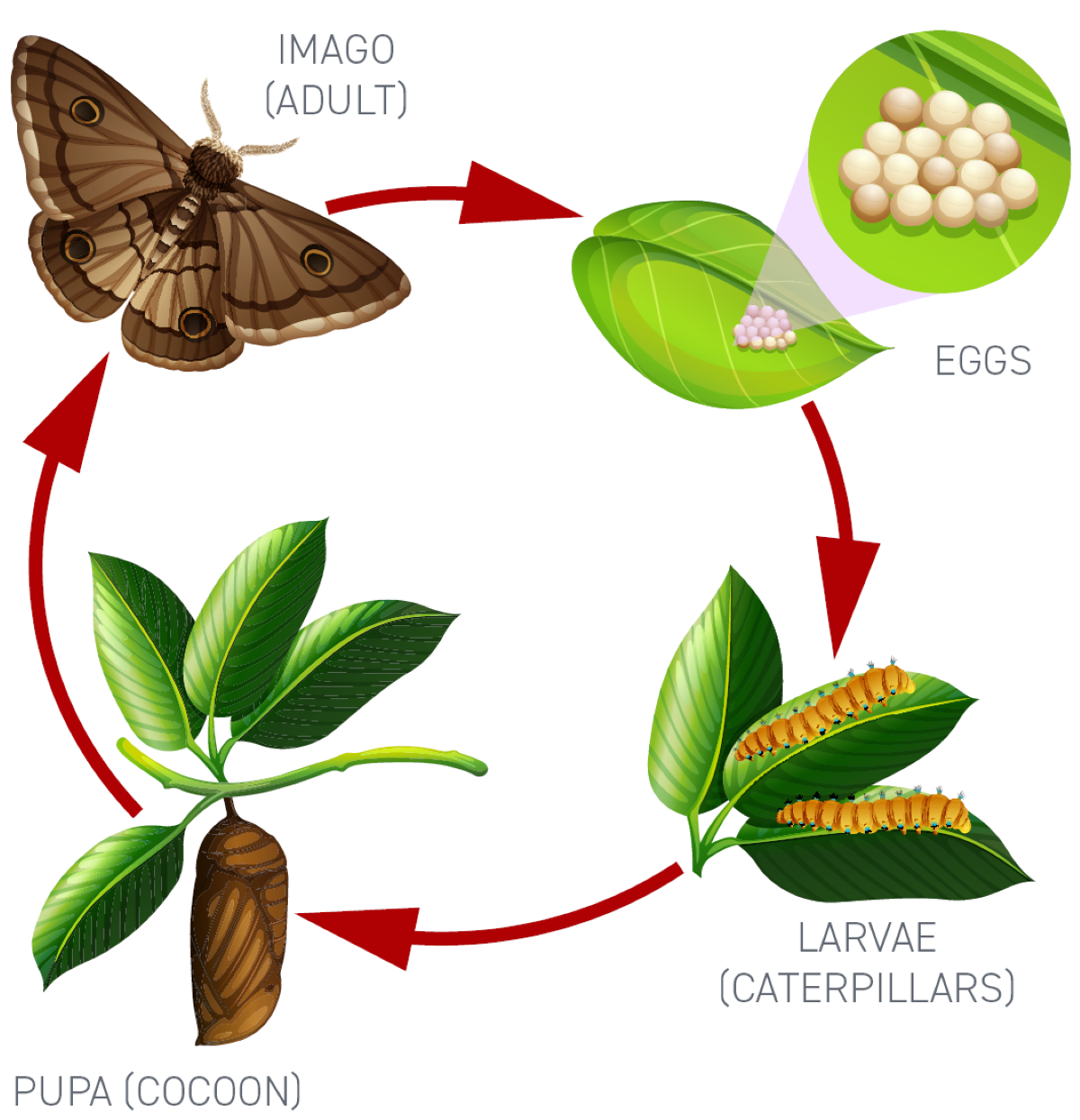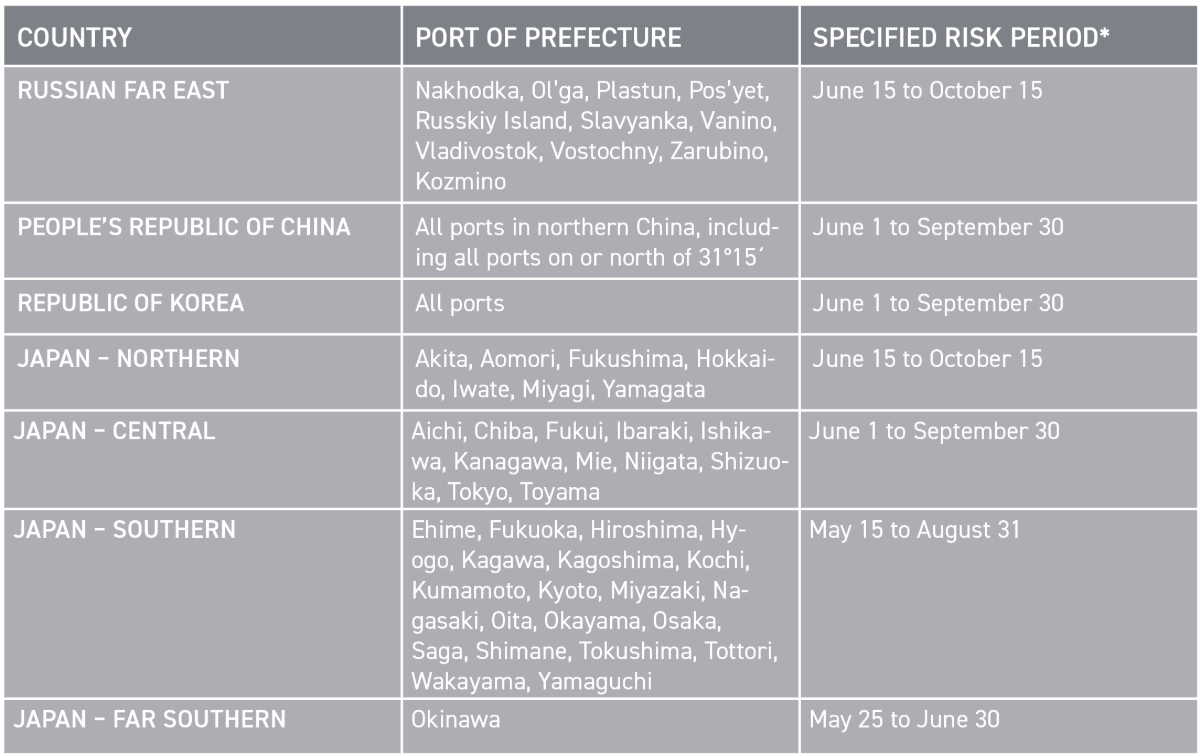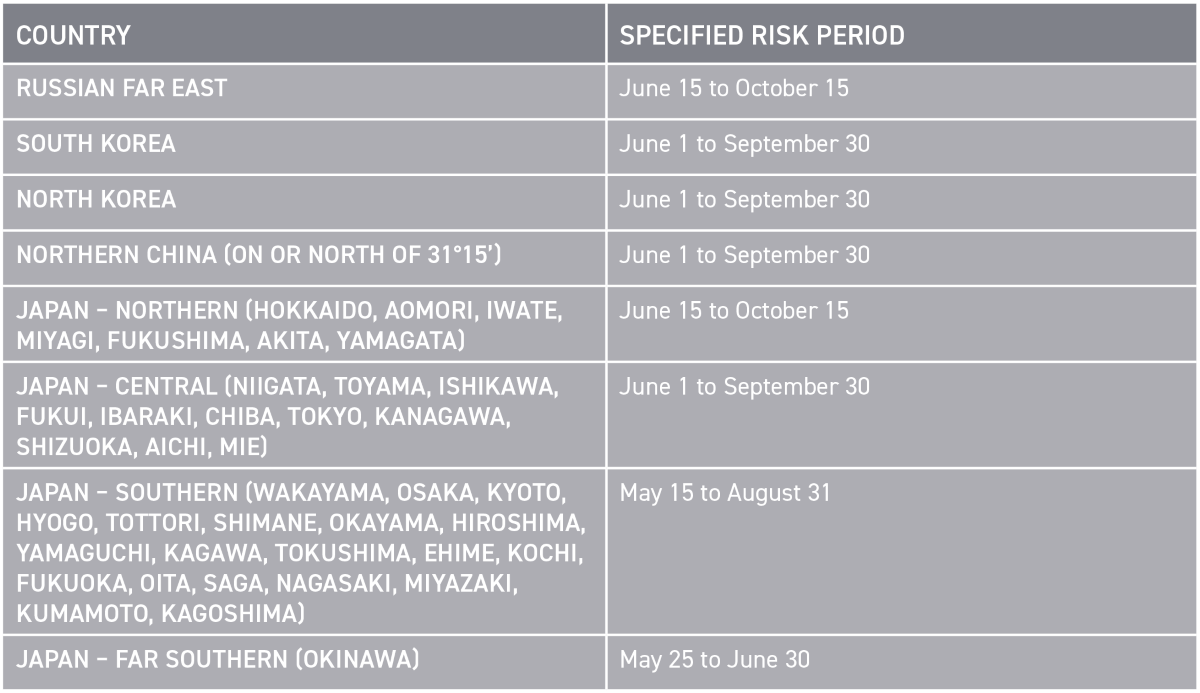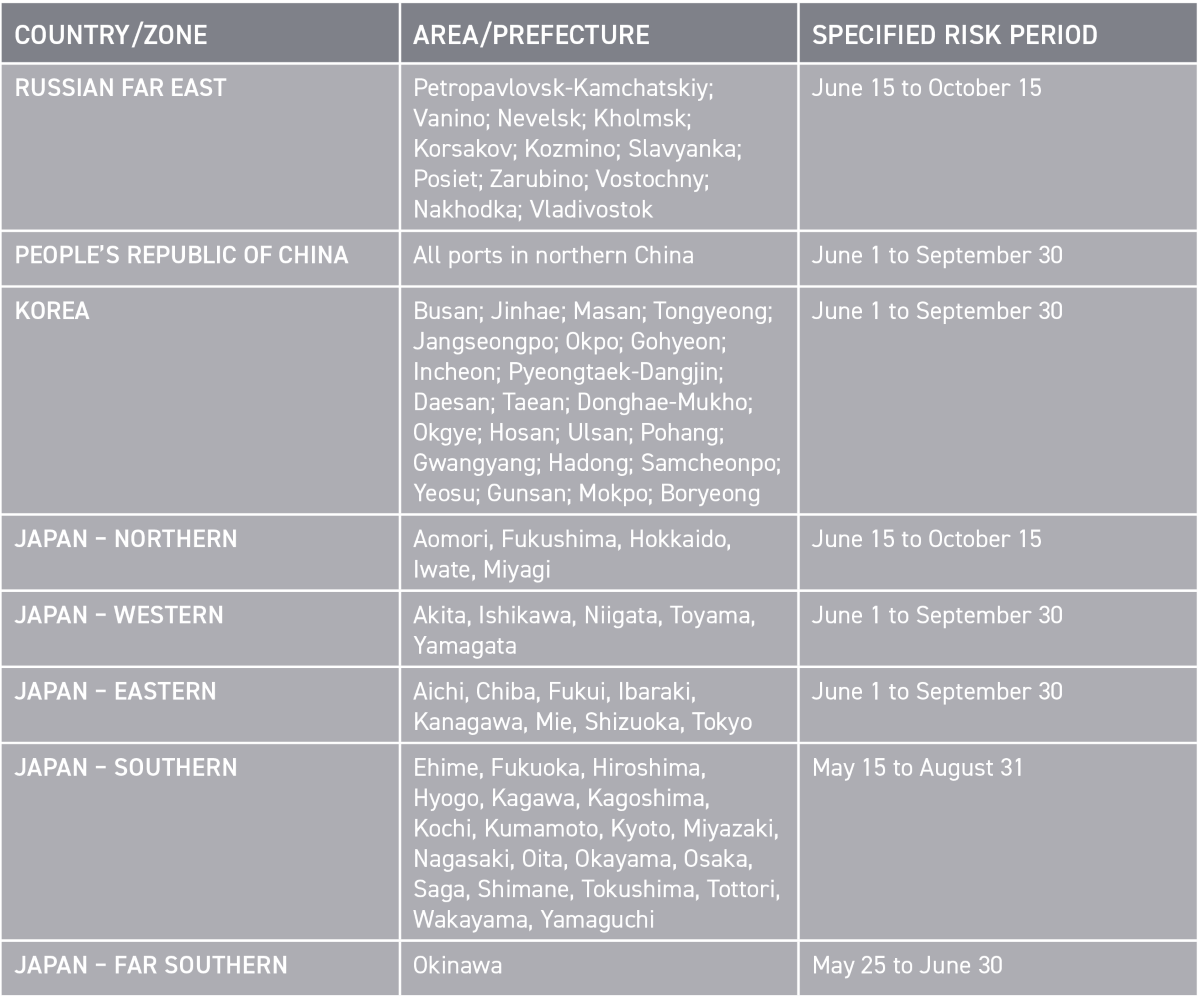This website uses cookies so that we can provide you with the best user experience possible. Cookie information is stored in your browser and performs functions such as recognising you when you return to our website and helping our team to understand which sections of the website you find most interesting and useful.
FLIGHTED SPONGY MOTH COMPLEX (FSMC) SEASON 2024 – FORMERLY ASIAN GYPSY MOTH
Published: 17 April 2024
The Lymantria Dispar, also known as the Flighted Spongy Moth Complex (FSMC), formerly known as the Asian Gypsy Moth, is a species of moths, native to China, far-East Russia, and other countries of the Asia-Pacific, such as Japan and Korea.
Spongy refers to the characteristic of the moth eggs which resemble a sponge-like mass. FSMC is a highly destructive pest posing a severe biosecurity risk. If transferred to non-native locations, the FSMC population is also less likely to encounter limitations imposed by natural barriers, such as predators, parasites, viruses, and competing species.
On this page:
- Life cycle and flight season
- Country-specific requirements
- United States and Canada regulated areas and risk periods
- Chile regulated areas and risk periods
- Argentina regulated areas and risk periods
- Australia regulated areas and risk periods
- New Zealand
- The role of crew in reducing FSMC infestation
- Other industry guidelines
- Charter party clauses
- Download FSMC advice PDF
LIFE CYCLE AND FLIGHT SEASON
The FSMC life cycle progresses through several stages, transforming from eggs to caterpillars, then evolving into pupae encased in cocoons, before reaching the adult stage as the final phase. Caterpillars feeding on leaves cause the destruction that renders FSMC a biosecurity risk.

FIGURE 1: Moth life cycle
Female moths lay eggs during the ‘flight season’, typically between May and October depending on the geographical location. To lay their eggs, they can fly as far as 40km, which contributes to the invasive potential of FSMC.
KEY POINTS
- FSMC is a destructive pest with the potential to cause severe damage to the environment
- Eggs laid onboard ships can transfer FSMC to new locations
- During flight season, female moths are attracted to lights and may lay eggs in sheltered spots on a ship’s hull, structures, equipment, and cargo
- FSMC eggs will survive almost any weather condition and temperature.
COUNTRY-SPECIFIC REQUIREMENTS
Several countries have introduced policies and regulations aimed at preventing the introduction of FSMC. If ships in these countries are discovered to be contaminated with FSMC egg masses, authorities may reject or subject them to quarantine measures. This could then lead to losses, substantial delays, and costly claims.
Consequently, masters, as well as owners and operators trading in the regulated areas, should be aware of the applicable requirements.
In the regulating countries, ships must declare whether they have called at ports in areas designated as FSMC (‘regulated areas’) during the current or previous flight season (‘specified risk period’). The majority of regulating countries also require ships to certify that they are free of FSMC on departure from the regulated area.
Furthermore, ships may be subject to an inspection on arrival to verify they are free of FSMC. These inspection regimes may be periodically tightened depending on the season and weather.
In addition to inspections and certification, some regulating countries require ships to complete a self-inspection before arrival. It is recommended that ships have a robust self-inspection routine in place, to address these requirements and to prevent them from arriving at ports with FSMC egg masses (self-inspection is discussed further below).
KEY POINTS
- Ships calling at ports in regulated FSMC areas during the risk period could be subject to procedural requirements in various destination states
- Ships typically need inspection before leaving the regulated area to demonstrate they are free of FSMC
- The ship must follow a notification procedure and provide the required documentation before arriving at a port in a destination state with a FSMC policy
- The ship may require self-inspection while on route.
The regulated areas, specified risk periods, and the associated requirements may differ from country to country.
The following summary outlines the requirements in countries with FSMC regulations for incoming ships. These requirements are subject to change and other countries may also introduce regulations. It is important that shipowners monitor the current situation closely and always contact their local representative before arrival.
UNITED STATES FSMC REQUIREMENTS
The United States Department of Agriculture’s (USDA) Animal and Plant Health Inspection Service (APHIS) maintains a dedicated website for its FSMC programme. This website provides links to further resources, such as applicable federal regulations and orders and reference material on pest identification.
The United States and Canada collaborate on measures to minimise the risk of FSMC incursion. At the time of writing, Canada and the United States’ latest Joint FSMC Industry Notice was issued in February 2024.
Both the United States and Canada base their FSMC policy on the specified risk periods published by the North American Plant Protection Organization (NAPPO).
U.S. AND CANADA REGULATED AREAS AND SPECIFIED RISK PERIODS

*Specified risk period is the period when there is a risk of FSMC flight and egg mass deposition
SOURCE: Joint FSMC Industry Notice, February 2024
The following requirements apply to ships that have called at regulated areas during the specified risk period in the last 24 months:
- Vessel should be inspected and certified free of FSMC by a recognised certification body. A copy of the certificate should be forwarded to the ship’s agents. A certificate is valid until the ship calls at another port in a regulated FSMC area during the specified risk period.
- Vessels must perform a self-inspection on route to find, remove, and destroy all FSMC life stages before entering a port.
- Vessels must provide port of call data (two years), at least 96 hours prior to arrival to the ship’s Canadian or U.S. agent.
Upon receiving the pre-arrival information, the U.S. Department of Homeland Security’s Customs and Border Protection (CBP) will determine whether the ship needs to be boarded on arrival for FSMC inspection. The FSMC programme lists the following enforcement monitoring actions:
- Certified vessels (vessels issued with a pre-departure FSMC inspection certificate from an approved entity in a regulated area) certificates along with additional research will be used for risk assessment to determine the need for inspection.
- Non-certified vessels will receive an FSMC inspection at all U.S. ports when the itinerary suggests FSMC risk.
- If FSMC is suspected on a vessel, re-inspections at subsequent ports will occur.
- If FSMC is detected, vessels are subject to receive removal orders and be removed from the port.
CANADA FSMC REQUIREMENTS
The summary of FSMC requirements is available on the Canadian Food Inspection Agency (CFIA) website.
Canada and the United States have harmonised their requirements related to FSMC. At the time of writing, the latest Joint FSMC Industry Notice was issued in February 2024. For the summary, please see the United States section above.
In 2017, the CFIA issued a policy clarification stating that the Canadian policy does not exempt bunkering locations. Therefore, ships should obtain inspection certification from all locations in the regulated area, including when bunkering at anchorage within these areas.
The CFIA notice states that during the high FSMC risk period in Canada (1 March – 15 September in Western Canada, and 15 March – 15 September in Eastern Canada), all ‘uncertified vessels’ (ships without an FSMC certificate issued after calling at a regulated area) will be directed to an offshore anchorage location for inspection by the CFIA. To avoid diversion upon arrival, vessels must obtain FSMC certification from at least the last port of call in a regulated area, or anytime afterward, before entering Canadian waters.
CHILE FSMC REQUIREMENTS
The agency responsible for the FSMC policy is the Chilean Servicio Agrícola y Ganadero (SAG – Agriculture and Livestock Service). SAG maintains a website dedicated to FSMC. Chilean requirements have been published in Resolution 4412/2013, amended by resolutions 8870/2015 and 8394/2021.
Similar to the United States and Canada, Chile has harmonised its FSMC policy with regulated areas and specified risk periods published by NAPPO.
CHILE REGULATED AREAS AND SPECIFIED RISK PERIODS

SOURCE: Chile Resolution 8394/2021
Ships that have visited regulated areas during a specified risk period within the last 24 months must supply SAG with a list of the ports they visited during that time frame. Additionally, they must provide a certificate, issued by a recognised organisation, confirming they were free of FSMC upon departure from the last port in the regulated area. This documentation must be provided by the ship’s representative/agent at least 24 hours before the ship arrives at a Chilean port. The agency will conduct SAG inspections based on its risk assessment, which will also dictate the inspection’s scope and location. Inspections will occur during daylight hours.
Further online resources published by SAG include FSMC inspection requirements and information posters in English for ships.
ARGENTINA FSMC REQUIREMENTS
The agency responsible for the FSMC policy in Argentina is Servicio Nacional de Sanidad y Calidad Agroalimentaria (SENASA – National Food Safety and Quality Service). The summary of applicable regulations are available here. FSMC is regulated by Resolutions 53w3/2022 and 764/2020.
Regulated areas and specified risk periods in Argentina have been partly harmonised with NAPPO and at the time of writing, last revised by Annex II to Resolution 533/2022.
It should be noted that Argentina defines regulated areas as all ports between latitudes 60°N and 20°N in listed countries. All Chinese ports have been listed as a regulated area (whilst NAPPO only included Chinese ports on or north of 31°15’N). Also, in Japan, there are several differences in assigning prefectures to specified risk period groups, compared with NAPPO – which results in different dates.
ARGENTINA REGULATED AREAS AND SPECIFIED RISK PERIODS

SOURCE: Annex II, Áreas de Origen y Períodos de Vuelo de las Hembras, August 2022
Ships that have visited regulated areas during a specified risk period in the last 24 months must furnish SENASA with a list of ports visited during the same period. They must also submit a copy of the FSMC-free certificate issued by a recognised organisation upon departure from the last port in the regulated area.
Ships that visited regulated areas outside of specified risk periods within the last 24 months, must also provide a list of ports visited during that timeframe. This documentation should be provided to SENASA by the ship’s agent at least 72 hours before the ships arrival at an Argentinian port.
SENASA will conduct inspections of ships for FSMC presence based on the agency’s risk assessment.
AUSTRALIA FSMC REQUIREMENTS
The Department of Agriculture, Fisheries and Forestry (DAFF) manages the biosecurity programme in Australia, including FSMC. DAFF maintains information relevant to FSMC requirements on its website. At the time of writing, the latest FSMC notice was issued in December 2022. The relevant regulation is contained in the Biosecurity Act 2015 with subsequent amendments.
DAFF receives pre-arrival information through the Australian Maritime Arrivals Reporting System (MARS). Upon submission of the pre-arrival report, MARS automatically emails an FSMC questionnaire to targeted vessels. DAFF’s criteria for high risk FSMC focuses on Russian far East ports.
AUSTRALIA REGULATED AREAS AND SPECIFIED RISK PERIODS

If the ship visited any regulated port during the specified risk period in the previous 24 months, it must also inform DAFF if it has undergone FSMC inspection and clearance by an agricultural authority in Australia, Russia, Canada, New Zealand, or the United States. Additionally, it should send a copy of the relevant clearance certificate.
The heightened FSMC surveillance period in Australian ports is typically between January 1 and May 31 each year. Upon receipt of pre-arrival information, the DAFF National Maritime Centre (NMC) will advise, through MARS, if an FSMC inspection or any specific biosecurity risk mitigation measure is required.
NEW ZEALAND FSMC REQUIREMENTS
The FSMC programme in New Zealand is managed by the Ministry for Primary Industries (MPI). MPI has published the relevant information on its Hitchhiker pests website. The requirements of the FSMC programme have been published in the Craft Risk Management Standard (CRMS) for vessels and the CRMS guidance document for vessels.
New Zealand’s FSMC-regulated areas and specified risk periods have been aligned with those published by NAPPO (see the United States section above). In consequence, specified risk periods were extended to 2023 in line with NAPPO. It should be noted that at the time of writing, the CRMS and CRMS guidance document have not been updated with these changes in the FSMC. However, ships should be aware of the revised risk periods and apply them accordingly.
Ships that have visited a regulated area during the specified risk period in the past 12 months (compared to 24 months elsewhere) must carry a valid pre-departure FSMC certificate, issued by a recognised organisation from the last port of call in a regulated area. The certificate should confirm that the ship was inspected during daylight hours on the same date as the ships departure. A copy of this certificate and the list of ports the ship called at in the last 12 months should be forwarded to MPI at least 48 hours before arrival.
Ships arriving without the required FSMC may require an inspection at a specific port determined by MPI, or potentially 4 nautical miles offshore at an agreed location in cases where the risk is deemed as very high.
THE ROLE OF CREW IN REDUCING THE RISK OF FSMC INFESTATION AND RELATED CLAIMS
Several countries regulating FSMC requires ships to carry out a self-inspection before arrival. Regardless of the regulatory requirement, a robust self-inspection is highly recommended to prevent losses, delays, and claims if FSMC is discovered after arrival. Where deemed necessary, self-inspection may be a part of a comprehensive pest management programme for the ship.
Instructions for self-inspection published by CFIA in Canada or MPI in New Zealand provide useful guidance, specifically for FSMC. The crew should be aware of what FSMC looks like, where to look for the egg masses, and how should they be disposed of. As egg masses are typically located in sheltered spots, self-inspections should be methodical and thorough. Self-inspections should be carried out before departure from the affected port and again on route/before arrival. Some areas should be inspected with particular attention, for example, areas adjacent to floodlights, which female moths are attracted to. Any egg masses should be scraped off and destroyed by incineration or in boiling water.
Self-inspections and disposal of FSMC egg masses should be carefully recorded with a log book entry. It is also advisable to secure photographic evidence.
OTHER INDUSTRY GUIDELINES
NAPPO published the standard ‘Regulating the Movement of Vessels from Areas Infested with the Asian Gypsy Moth’ (RSPM 33) which has been widely used as the reference in setting out FSMC management policies. NAPPO has also been instrumental in the recent revision of the FSMC-specified risk periods.
CHARTER PARTY CLAUSES
BIMCO developed a generic Flighted Spongy Moth Complex Clause for Time Charter Parties which provides a commercial solution focussing on the basic obligations and responsibilities of the owners and the charterers.
Shipowners play a vital role in reducing the spread of FSMC as an invasive pest. A solid understanding of FSMC and its associated requirements by ship masters, shipowners, and operators plays a crucial role in mitigating the risk of losses and delays in regulating countries stemming from FSMC detection or non-compliance with local requirements.
Considering the potential period of up to 24 months between the call at a regulated area and the point where the FSMC policy will apply, it is highly recommended to have a robust programme of onboard compliance with regulatory requirements related to FSMC.
For further information, please do not hesitate to contact the loss prevention department.
The Club would like to extend our sincere appreciation to Triglav Maritime – Captain Slav Ostrowicki for contributing his technical inputs to this article.

 English
English